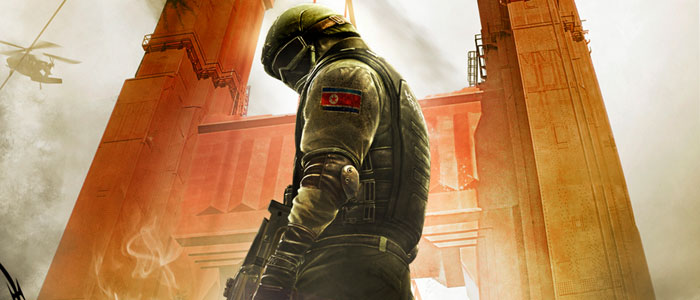[tab:Review]
Alternate histories are often some of the most interesting fiction. With the onslaught of first-person shooters hitting the market these days, it is hard to stand out. You aim down the sights, pop in and out of cover, and generally take out wave after wave of bad guys. Kaos Studios is looking to change that with their latest FPS, with a new take on the Red Dawn scenario. While I love what is being presented in the narrative, the strong story won’t keep you from taking notice of the game’s various shortcomings.
From the opening cinematic to the closing standoff, Homefront takes the FPS narrative into a realm in which it rarely makes an appearance. When it works, it works well, and the characters and story are brought to the forefront for some truly compelling storytelling. This is America after a powerful Korean army has invaded and completely destroyed our homeland. War-torn America is represented with smoked-out buildings, prison camps and some truly disturbing imagery. Kaos has done an outstanding job of driving home the sense of our country in defeat.

You play as speechless protagonist Jacobs, rescued by the resistance because of your abilities as a pilot. You then join up, establish relationships with the team and embark on a mission to turn around the war effort. Amazingly, you do all of this in a short amount of time as the campaign is criminally short even by FPS standards. I finished the game in two sittings, and could have easily done it in one if I didn’t have a prior engagement. There are seven missions, and each one ends long before it ever gets going.
Thankfully, even as short as it is, there are some great moments found in the campaign. The final level is truly epic on several levels and I really enjoyed the vehicle segments, especially when you finally get to answer your call towards the end and take control of an attack chopper. There are also plenty of disturbing images throughout the main game including soldiers killing parents in front of their children and a twisted baseball field scene that truly tugs on your patriotism. The game crosses lines previously unexplored by other titles in the genre, and it remains the only true selling point to the campaign.
Outside of the story, the actual gunplay is, sadly, mediocre at best. It is not that Homefront is incompetent in any respect, but it fails to push the genre, mimicking every other shooter so much it fails to achieve an identity of its own. Rarely do you end up running around alone and, as in most shooters, your cohorts are invincible Stormtroopers, meaning they are terrible shots. Still, they end up being great bullet shields. Another small quirk is that the game gives you little freedom to explore. In fact, you will be led by the hand most of the time and hit invisible walls if you try to move ahead of your band of rebels.
Amazingly, where the real meat of the game feels focused is the multiplayer. With so many players dedicating their time to a certain “Duty”, it is hard to coerce them away. Homefront actually has a pretty competent online offering that ends up being more fun than you would expect. It reminded me of a mix between CoD and MAG, but not nearly as robust or polished as either one. All modes are team-based, including standard team deathmatch; ground control (think King of the Hill); and Battle Commander, which is a mesh of both of these modes with an AI-controlled commander that disperses other objectives. All modes are genuinely entertaining when you manage to fill up a room with players.

Much like CoD, or any other online shooter, Homefront offers up bonuses for points earned during the game. Each class has access to certain perks such as vehicles, rocket launchers and armor. You can purchase these on the fly by pressing the corresponding button on the d-pad. Points are also dispersed more based on team actions as opposed to individual achievements, further stressing the cooperative mode of team play. There is a lot to love about the online mode once you start to get down and dirty with it, but the real question is, “will it stand the test of time?” Lack of maps and frequent bouts of low player activity may be the nail in this game’s coffin.
Another area where Homefront falls short is its visuals. The game is certainly not as polished as most of the current generation shooters. However, what it lacks in visual fidelity it makes up for with consistency. The frame rate never drops and there are no weird issues. The game reminded me quite a bit of Half Life 2, without the awesome physics. Sound wise, there isn’t much to write home about. The vocal performances are acceptable but lack that special something that draws you into the characters. The music is good at times, forgettable at others and the sound effects never really have that depth you want. Overall, the game just feels sort of rushed and last-gen.
Homefront is a game that will live or die based on its online component. For $60, if you are investing solely for the single-player campaign, you are truly wasting your money. The multiplayer has the potential to be something amazing with a few tweaks and a better selection of maps, currently there just aren’t enough. If you are looking for something to take your mind away from “that other big shooter,” then this is a refreshing change of pace. Just keep in mind that it isn’t going to set the world on fire with its innovation.
Review copy provided by publisher.
[tab:Screenshots]
[tab:END]
